Event-Driven Architecture has a certain mystique. It’s frequently heralded in boardrooms and planning sessions as the go-to solution for scalability and resilience. For ambitious CTOs and business owners, the temptation to adopt the EDA holy grail from day one sounds like a smart bet.
But adopting EDA without real need is like buying a Formula 1 car for grocery runs. It’s impressive but unnecessarily complex. The key is to recognize that EDA isn’t a trendy upgrade but a targeted remedy to specific architectural pain points.
Having been in the Ruby on Rails development services market for over a decade, we’ve guided many clients toward solutions that truly fit their needs, never pushing them to overly complex or costly solutions.
After reading this post, you’ll understand when EDA makes sense, its benefits and limitations, the main Rails tools that help, and key advice to help you make more informed, conscious decisions.
Contents
- Types of architecture possible in Ruby on Rails apps
- Event-driven architecture’s anatomy: core components
- Benefits and limitations of using event-driven architecture in Ruby on Rails
- When to use event-driven architecture in Ruby on Rails
- When EDA doesn’t fit and what to use instead
- Rails tools & libraries for event-driven architecture
- Tips to consider before diving into event-driven architecture
- Wrapping up: should you adopt EDA for your Rails application?
Types of architecture possible in Ruby on Rails apps
Rails applications don’t come with architectural destiny written in stone. You wouldn’t use the blueprint for a cozy cottage to build a sprawling international airport, and vice-versa. The right plan depends entirely on what you want to build, how many people you expect it to serve, and how you anticipate it will grow.
There are several popular blueprints. While we could get lost in dozens of patterns, most applications you see today are built on one of three foundational ideas. Let’s look at the ones most relevant to our discussion.
1. Monolith
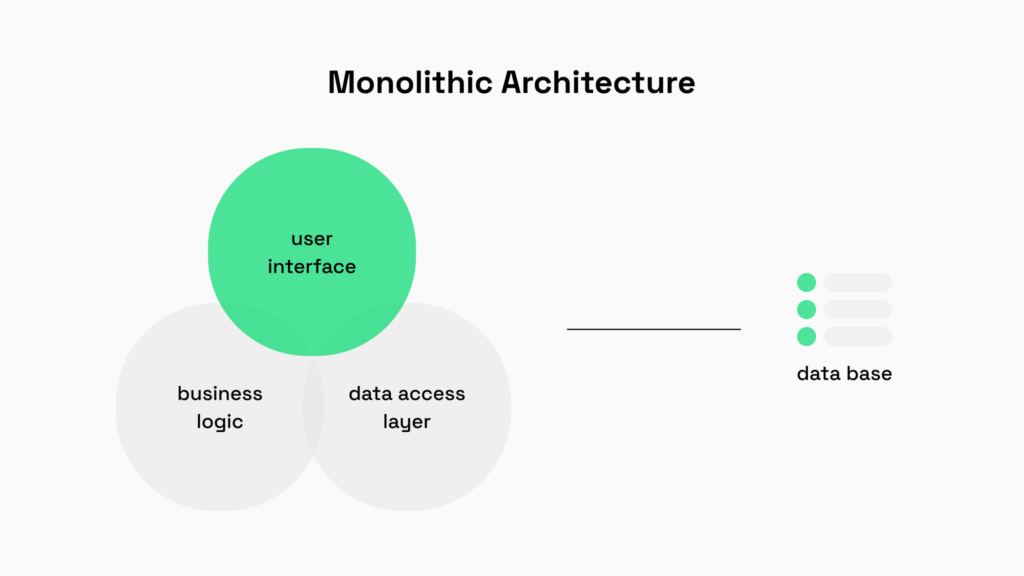
Monolithic architecture is the classic, traditional approach, and it’s where most applications begin their journey. A monolith is a single, massive codebase where all the features like user authentication, payments, dashboards, and so on, live together under one roof. Think of it as a corporate headquarters where every department works in the same building.
When it’s best to use: Getting a new product to market quickly. It’s simpler to develop, test, and deploy in the early days. This is why it’s a fantastic choice for many SaaS products, like a new project management tool. Monolith is perfect for Rails scalability for startups at the MVP stage.
2. Microservices
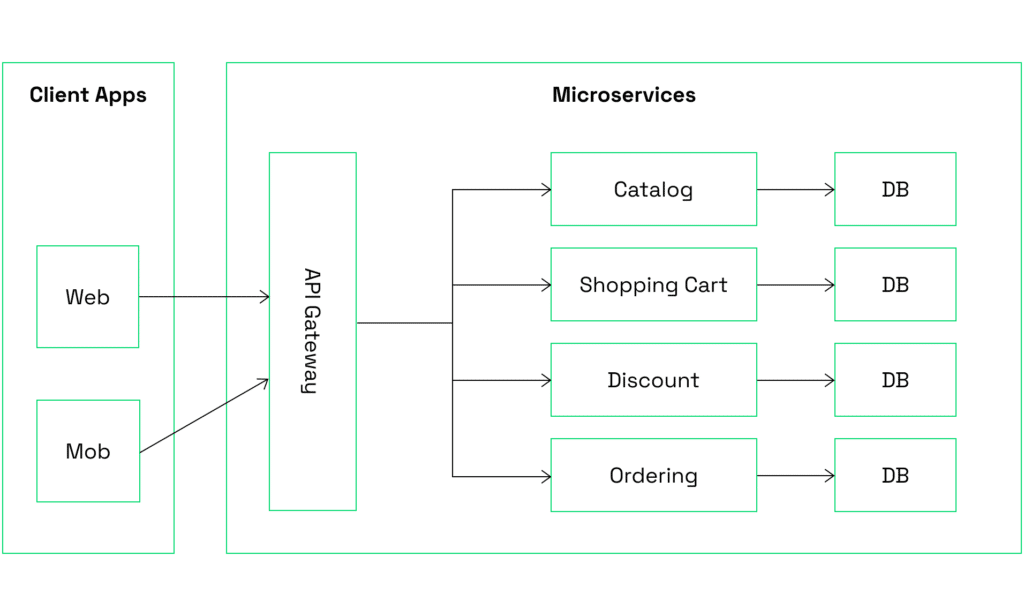
As a business grows, our single headquarters can get crowded, becoming a bottleneck. Rails microservices architecture solves this problem by breaking a large application into a collection of smaller, independent services. Each service is a specialist, focused on doing just one thing perfectly. One service handles user profiles, another handles the shopping cart, and a third manages payments. They are like a chain of specialist boutiques, each with its own staff and inventory, that communicate with each other over a network.
When it’s best to use: Large, complex platforms that need to scale massively. Different teams can work on different services independently, and if the payment service gets a huge surge of traffic, you can scale it up without touching the user profile service.
3. Event-Driven Architecture (EDA)
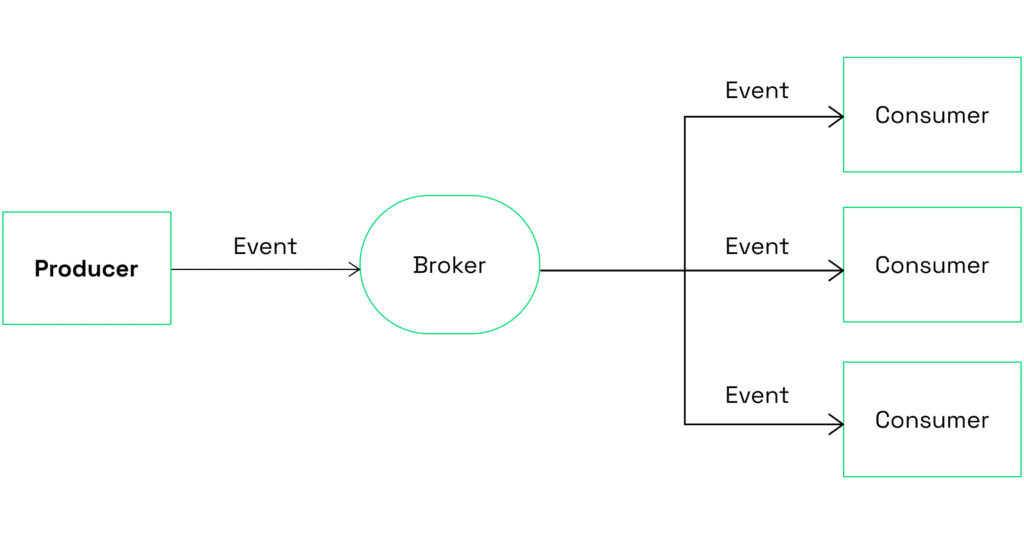
This is the architecture we’re interested in. Instead of services directly commanding each other like in the previous case, here they communicate only when it’s “necessary” by announcing “events.” One service posts a notice on a central bulletin board, and any other service that’s interested can read it and react immediately. The original service doesn’t need to know who is listening or what they will do with the information.
When it’s best to use: Applications with complex workflows where many things need to happen in response to a single action. A SaaS platform with multiple applications and services, like Zeitview, is a good example.
There, we leveraged event-driven architecture principles to enhance collaboration between multiple services and applications that support the client’s inspection workflows.
In one of our recent implementations, Kafka and ActiveMQ were used as key middleware components in the data pipeline for site asset processing. A third-party service pushes raw data into Kafka, where a Ruby on Rails application consumes it. This application then forwards the messages to ActiveMQ, from which another application built on a different tech stack pulls the data and assets to deliver them to customers.
This architecture enables high-throughput, asynchronous communication between decoupled components, efficiently handling over 1.2 million records. Kafka and ActiveMQ were selected specifically for their ability to support this scale, ensuring reliable and performant data transfer across the system.
You can build an application using any of these architectures with almost any modern technology stack. But doing it with Ruby on Rails is a unique experience.
Rails is famous for its “convention over configuration” philosophy with a balance of speed, simplicity, and power. It provides smart defaults and established patterns that let developers focus on building features instead of re-solving solved problems. This philosophy extends to how it handles these complex architectures, making the development process smoother and more predictable.

How event-driven architecture differs from the traditional architecture
To really grasp the difference, let’s contrast EDA with the more traditional approach found in many monolithic applications.
The traditional, request-response model works like a chain of command. The OrdersController (the Captain) directly commands the PaymentGateway (the First Mate), waits for a response, then commands the InventoryService (the Sailor), and so on. It’s a synchronous, tightly coupled process. If the Sailor is slow to respond, the entire chain of command freezes, waiting. The Captain is intimately aware of every crew member’s job and sequence.
The event-driven model, on the other hand, works like a ship-wide broadcast. The Captain simply announces over the intercom, “We have docked at the port!” The engineering team hears this and knows to power down the engines. The cargo team hears it and begins preparing the cranes. Each team acts on the announcement independently and in parallel. The Captain doesn’t need to know the inner workings of each team; they just trust that the right people are listening for the right announcements. This creates a system that is asynchronous, resilient, and beautifully loosely coupled.
Now, let’s see how EDA technically works.
Event-driven architecture’s anatomy: core components
What is event-driven architecture in Ruby on Rails?
At its core, EDA is a philosophical shift in how parts of your application communicate. Instead of a rigid, top-down command structure, it creates a more dynamic and organic system where components react to things that happen. The “thing that happens” is the cornerstone of this entire concept: an event.
An event is simply a record of something significant that has occurred. Crucially, it’s an immutable fact from the past. It’s not “Process Order,” it’s “Order Placed.” It’s not “Update Inventory,” it’s “Item Shipped.” This might seem like a subtle difference in wording, but it represents a monumental change in perspective. You’re no longer telling other parts of your system what to do; you’re simply announcing what has already been done.
EDA key components: what’s inside
Any event-driven architecture relies on the key distinct parts working in harmony. Each component has a very specific and important job to do.

1. Events
An event is a record that something meaningful happened in the system, like OrderPlaced, UserSignedUp, or PaymentFailed. Events are usually immutable and contain enough context for other parts of the system to respond.
It’s an event as a message that says: “This happened.”
2. Event producers
These are the parts of your application that emit events. For example, a checkout service might publish an OrderPlaced event when a user completes a purchase.
Producers are unaware of who will consume the event. They simply emit it and move on.
3. Event brokers
An event broker receives events from producers and routes them to one or more consumers. It acts as a central hub that decouples producers from consumers.
In Rails, this could be an internal mechanism like ActiveSupport::Notifications, or an external system like Redis (via Sidekiq), RabbitMQ, or Kafka.
4. Event consumers
Consumers subscribe to and react to events of interest. For example, a notification service might listen for an OrderPlaced event and send a confirmation email.
Multiple consumers can respond to the same event independently, enabling modular and scalable behavior.
EDA is built on four core components: events, producers, brokers, and consumers. Producers emit events like OrderPlaced, brokers route them, and consumers react, all without tight coupling. Optional handlers and event stores add flexibility and traceability, making your system scalable, modular, and responsive to change.
Benefits and limitations of using event-driven architecture in Ruby on Rails
Let’s start with the benefits of Ruby on Rails event-driven architecture and later see what limitations EDA has to offer.
Benefits
- Loose coupling between components
EDA allows different parts of your application to communicate without being directly dependent on each other. This makes the system easier to maintain and extend. - Improved scalability
One major advantage is scalability. For example, if you’re sending tens of thousands of messages daily between services over HTTP, it can become slow and resource-intensive. With event-based architecture (e.g., Kafka), communication becomes more efficient and scalable. You can scale Kafka itself depending on the load. - Better system observability
Since events can be logged and stored (e.g., in an event store), it’s easier to trace what happened, when, and why. This helps a lot with debugging and monitoring. - Asynchronous processing
Events can trigger background jobs, which improves application responsiveness and performance by offloading heavy or non-urgent tasks. - Easier integration with third-party services
By emitting events, you can allow external services to subscribe and react without modifying your core logic. - Fewer code dependencies
Services or modules don’t need to directly call each other, which leads to cleaner and more modular codebases.
Event-driven architecture invites us to think differently. Not in terms of direct commands, but in terms of signals and responses. It’s less like a marching band and more like jazz: everyone listens, everyone plays their part, and the beauty comes from harmony, not control. But like jazz, it requires discipline. Without structure, the music turns to noise.
Let’s uncover EDA’s key drawbacks.
Limitations
- More operational complexity
Adding Rails Kafka integration, Redis, or another message broker adds infrastructure overhead. You’ll need to monitor, maintain, and scale these components separately. - Eventual consistency
Since events are processed asynchronously, data might not be immediately updated across the system. This requires careful handling of consistency and potential race conditions. - Harder to trace flow across services
When many services are reacting to the same events, it can become difficult to follow the full lifecycle of a process, especially without strong logging and observability tools. - More moving parts to coordinate
With decoupling comes more parts to manage, like producers, consumers, brokers, handlers and more chances for miscommunication or bugs due to missed or malformed events. - Potential for chaos
While you gain flexibility, it’s easier to lose control of the system’s behavior as more services begin emitting and reacting to events. This is why good documentation and event contracts are essential. - Steeper learning curve
Teams new to EDA may face a learning curve in understanding message flow, broker configuration, and debugging asynchronous systems.
Whether or not you need EDA from the beginning depends on your app type and the industry you’re in. Below, you’ll find the best use cases for Rails event-driven design.
When to use event-driven architecture in Ruby on Rails?
| Scenario | Why EDA Fits | Explanation |
| Multiple services need to react to the same event | Loose coupling | EDA allows different parts of your app (or microservices) to independently respond to events like UserSignedUp without knowing about each other. |
| You want to decouple business logic | Better separation of concerns | Emit events from your core logic and let subscribers handle side effects like sending emails or updating analytics. |
| Asynchronous processing is needed | Improves performance | EDA supports background job queues via ActiveJob or Sidekiq, allowing long-running tasks to be handled later. |
| You plan to scale or move processing 100K+ records quickly | Scalable communication | Events can be published to message brokers (e.g. Kafka, Redis) and consumed by other services without tight integration. |
| Audit trails or history of actions is important | Event logging | Using an event store, you can track system activity over time for debugging, analytics, or compliance. |
| You want to build reactive, real-time features | Real-time responsiveness | Events can trigger live updates via ActionCable or external systems like WebSocket servers. |
| You’re integrating with third-party systems | Integration flexibility | Emit events when key actions occur (e.g. PaymentReceived), and let external services subscribe or react via webhooks or APIs. |
When event-driven architecture doesn’t fit and what to use instead
EDA has its place, but it’s not always the right tool. Here are some clear signs that Rails event-driven architecture might not be the best fit and what to use instead:
For early-stage startups & prototypes
Your primary goal is speed and finding product-market fit. The complexity of setting up brokers and managing events will slow you down significantly.
Alternative: Build a classic Rails monolith. Focus on clean, well-structured code. This approach is faster to develop, easier to debug, and simpler to deploy, giving you the agility you need in the early days.
For simple CRUD applications
If your application primarily involves creating, reading, updating, and deleting records without complex follow-up actions (e.g., a simple blog or contact manager), EDA is unnecessary.
Alternative: Use standard Rails conventions. Rely on callbacks, service objects, and background jobs (via Sidekiq or Active Job) for any simple, asynchronous tasks. This keeps the architecture straightforward and leverages Rails’ core strengths.
For processes requiring immediate consistency
EDA is “eventually consistent,” meaning there’s a slight delay before all parts of the system are updated. This is unacceptable for critical, atomic operations like financial transactions where you need a guaranteed, immediate success or failure.
Alternative: Use synchronous, direct method calls within a database transaction. Wrap the entire sequence of operations in a transaction block to ensure that either every step succeeds or they all fail together, maintaining perfect data integrity.
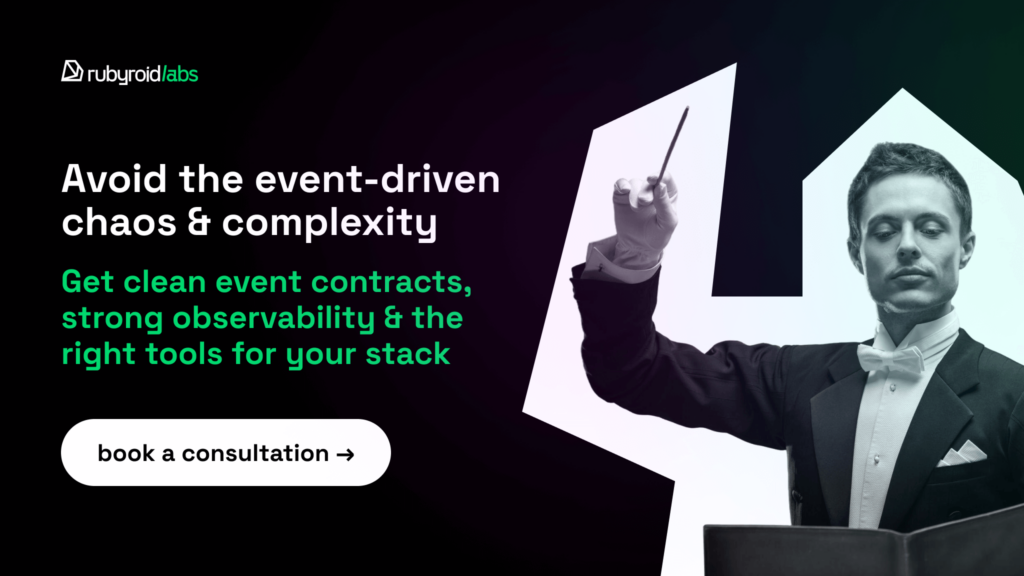
Rails tools & libraries for event-driven architecture
Rails doesn’t come with a built-in event-driven system “out of the box.” Its default architecture is basically a monolith, designed for simplicity and speed in the beginning. However, the true power of the Rails ecosystem is its incredible flexibility and the rich collection of libraries (gems) that allow our developers to build a rock-solid, event-driven architecture when the need arises.
Here are the best RoR tools that we use for building event-driven architecture for our clients.
1. Wisper
Wisper is a Ruby gem that provides a simple, lightweight, in-process event bus. It’s great for “decoupling” different parts of your monolith without the complexity of external services.
- How it works: When a user is created, your model can “broadcast” a user_created event. Other parts of your code, called “listeners,” can subscribe to this event to perform actions like sending a welcome email.
- Best for: Your first step into EDA. It’s perfect for cleaning up a large monolith and making your code more modular and easier to maintain.
2. Sidekiq (with Redis)
Sidekiq is the most popular background job processor in the Rails world. While not a pure EDA tool on its own, it’s the engine that powers asynchronous behavior. It uses Redis as a simple and fast message broker to manage queues of jobs that need to be done.
- How it works: When an event happens (e.g., “Export Report”), you don’t make the user wait. Instead, you create a background job and hand it to Sidekiq. Sidekiq then processes this job on a separate thread, ensuring your application stays fast and responsive.
- Best for: Handling any slow or complex task that shouldn’t block the user interface. It’s the workhorse for making your application feel snappy.
3. RabbitMQ
RabbitMQ is a powerful, dedicated message broker. If Redis is a simple to-do list, RabbitMQ is a full-blown post office. It’s an external service designed specifically for routing messages reliably between different applications (like microservices).
- How it works: A “producer” (your Rails app) publishes an event to RabbitMQ. RabbitMQ, based on rules you set, then delivers that message to one or more “consumers” (other services). It guarantees message delivery, even if a consumer is temporarily offline. The
bunnygem is a popular way to connect Rails to RabbitMQ. - Best for: Building a true microservices architecture where different applications, potentially written in different languages, need to communicate reliably.
4. Apache Kafka
The Karafka framework is a modern and comprehensive choice for implementing Kafka in Ruby on Rails, enabling robust Rails kafka integration. While RabbitMQ is like a post office that discards letters after delivery, Kafka is more like a newspaper archive that keeps a permanent record of every event.
- How it works: Producers publish events to Kafka “topics.” Consumers can read and re-read these events at any time. This allows for powerful features like event sourcing, where you can replay the entire history of events to rebuild the state of your application.
- Best for: High-throughput systems that need to process massive streams of data in real-time, such as IoT platforms, real-time analytics, or large-scale FinTech applications.
Tips to consider before diving into event-driven architecture
Over the years, we’ve seen clients rush into an event-driven model because it’s modern and promises incredible scale. We’ve also seen the immense success it can bring when adopted for the right reasons and at the right time.
So, before you commit to this powerful architecture, here are some hard-won lessons and practical advice our tech leads share.
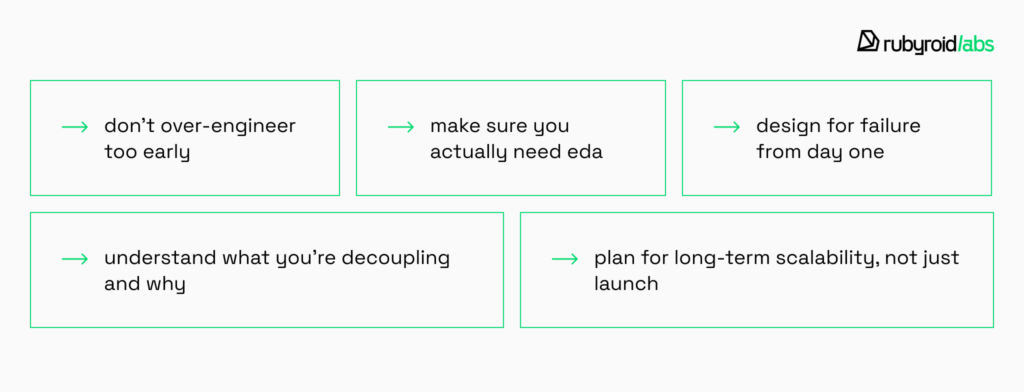
Don’t over-engineer too early
Start simple and then decouple.
If you’re still validating your product-market fit, don’t rush into full-blown Rails microservices architecture or Kafka pipelines. Begin with a clean monolith, and introduce asynchronous events with tools like Wisper (a simple Ruby on Rails event bus) or Sidekiq for background jobs. These give you modularity and responsiveness without the overhead of distributed systems.
Use the rails pub/sub pattern internally with something like Wisper to decouple services before you even think about Kafka or RabbitMQ.
Make sure you actually need EDA
EDA is a response to complexity, not a goal in itself.
Ask yourself:
- Do we have multiple teams or services that need to evolve independently?
- Are we dealing with high volumes of real-time data (e.g., IoT, analytics, video processing)?
- Do we need scalable event-driven workflows in Rails, or are we just trying to avoid slow controllers?
If your app is still manageable as a monolith, don’t fragment your architecture prematurely. Sometimes, Rails + background jobs (e.g., Sidekiq, ActiveJob) are all you need.
Understand what you’re decoupling and why
Events are great until you lose visibility.
In event-driven systems, one action can trigger 5, 10, or 50 downstream processes. Without proper observability, debugging is a nightmare.
So, before implementing EDA:
- Set up Rails observability & monitoring (e.g., Honeycomb, Datadog, or OpenTelemetry).
- Build structured logging for every event (with unique IDs).
- Embrace domain-driven design in Rails. Events should reflect meaningful business actions, not just tech-level triggers.
Design for failure from day one
Distributed systems fail in new and exciting ways.
When you go event-driven, you’re introducing asynchronous behavior and message queues, which means things can (and will) go wrong:
- A consumer might go down.
- A message might fail to deliver.
- A job might retry 10 times and still fail silently.
Pro tips:
- Use dead-letter queues (DLQs) in Kafka or RabbitMQ.
- Instrument retry logic with Sidekiq.
- Set up monitoring dashboards for your queues and workers.
Plan for long-term scalability, not just launch
If you’re building a system that must scale, EDA is often the way forward. But plan for gradual adoption:
- Start with event-driven workflow in Rails inside your monolith.
- Use Sidekiq + Redis for asynchronous processing.
- Add Kafka or RabbitMQ when you outgrow your current setup.
- Consider enterprise Rails event-driven solutions only when your team is ready to maintain them.
Before diving into event-driven architecture in Rails, take a step back and evaluate your real needs. EDA can bring powerful benefits like scalability, modularity, and asynchronous processing, but only when introduced at the right time, with the right tools, and for the right reasons.
Wrapping up: should you adopt EDA for your Rails application?
Event-driven architecture can be effective for building scalable, modular, and resilient Ruby on Rails applications but only when used with intention.
It’s not a one-size-fits-all solution, and adopting it too early can add unnecessary complexity. If your Rails app is still in its early stages or doesn’t require asynchronous workflows, tight decoupling, or real-time integrations, a well-structured monolith with tools like Sidekiq or Wisper may be all you need for now.
However, when your platform starts to show signs of strain like slow background jobs, tangled business logic, or the need to scale teams and services, Rails event-driven architecture becomes vital. With the right combination of tools, you can evolve your system architecture step by step.
The key our advice is don’t chase trends and build for your actual needs, and let architecture follow the shape of your business, not vice a versa.
If you’re unsure how to implement event-driven architecture in Rails, consider working with teams that specialize in ruby on rails architecture consulting or rails event-driven development services. The right guidance early on can save you months of pain.




